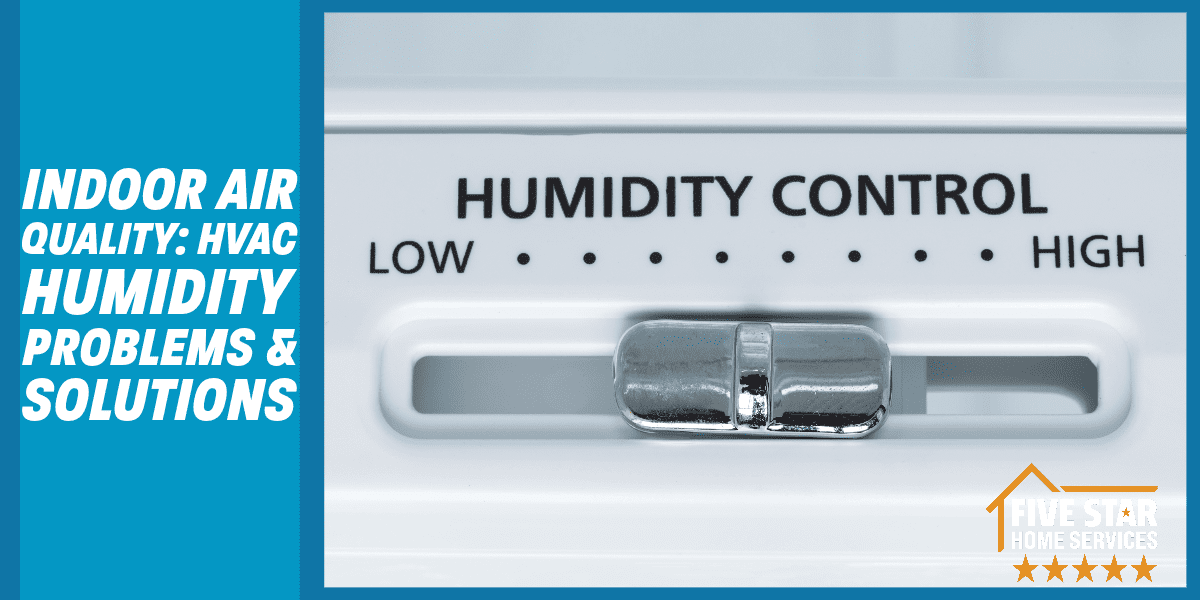Humidity affects every aspect of home comfort throughout the year. Learn about some of our HVAC solutions to help control humidity problems. See which products are right for you and your home.
Indoor Air Quality: HVAC Humidity Problems & Solutions
The humidity in your home’s air is as important as temperature when it comes to your overall. If that sounds like a bold statement, no worries! We will elaborate.
When most people think about heating and air conditioning in their homes, they tend to focus on the temperature. Relative levels of humidity levels, nevertheless, play an important factor in how this temperature feels. Humidity also affects other aspects of our home — how easily certain pests can live in our walls and whether or not mold can grow in our HVAC system. It also affects how rough allergy season will be.
There is a bright side to this: HVAC equipment helps manage these issues, in addition to many others. Nevertheless, sometimes it requires proactive management on the part of homeowners.
The following article is designed to do several things:
- Help you determine which ones aren’t the most necessary for you
- Help you understand how HVAC products control your humidity
- Help you decide which are necessary for your home comfort needs
All three of these areas are important. However, it isn’t always about adding more pieces of equipment. What it is, though, is about identifying areas of need based on your circumstances and figuring out how to solve those issues.
Humidity Control
Did you know the relative humidity in some homes can reach as low as 15% during the winter? To give you a little context, the average relative humidity of certain deserts is 25%. It needs to be kept above 35%! Otherwise, low humidity can irritate your respiratory system and dry out your skin. Low humidity also increases your risk of illness and causes structural damage to the woodwork in your home. A lot of wooden floor manufacturers only provide warranties for their work if the home has a whole-home humidifying system.
Additional problems associated with humidity (high or low) can include the following:
- Musty smell
- Asthma issues
- Water stains
- Cupped wood floors
- Permanent window fog
- A general decrease in comfort
- Irritated throat in the winter
- An overly warm upstairs or finished attic
- Peeling or blistering wallpaper and paint
- Spiders, bug infestations, and cobwebs
- Black mold or other mold growth in damp areas
- Wild discrepancy between temperatures on different floors of the home
- Creaky floorboards in a dry environment or moisture damage in humid environments
- Allergies, either seasonal or due to a specific environmental trigger
Although you might not experience each of these — even one or two can be comfort-killing if they aren’t kept in check. In the following, we will unpack each to see what can be done to mitigate them.
How damp is your basement damp in the summer?
For a lot of homeowners here in Ohio, the answer is “very.” With the relative humidity regularly hitting the 80 to 90% range here in Central and Southwest Ohio, it causes issues indoors. Anything above 60% relative humidity puts us at risk of developing black mold. While an ideal level can vary, 35% to 60% is usually a safe range to stay inside of.
Because a lot of insects absorb moisture through their skin to stay hydrated, higher levels of humidity allow more to thrive inside the home. Although the optimal range for minimizing bugs can again vary, at or below 50% humidity is adequate for managing potential bug problems.
Knowing this, homeowners can proactively manage their indoor humidity levels by utilizing the following options:
Whole-Home Humidifiers
Ducted, whole-home humidifiers are an excellent solution! Although a lot of homes do fine in the winter, many do not. If you ever experience any of the problems we listed above, you will benefit tremendously from a whole-home humidifier.
Although costs can vary, the following are a couple of rules that tend to hold true:
- The larger your home, the more powerful your humidifier needs to be, which in turn affects the overall cost.
- Mobile humidifiers cost less and are great for specific situations. However, they will never be able to service an entire home, or even a meaningful portion of a home.
- If possible, it’s usually a lot cheaper to have this installed at the time of a full HVAC system replacement. You can save on labor costs; it might also be able to take advantage of company incentives for pairing equipment and services.
Whole-Home Dehumidifiers
On the flip side, dehumidifiers are great to have during the summertime. They help reduce allergies, reduce bugs, and other pests. Mold isn’t as much of an issue. There’s less window fog, fewer smells, and greater comfort.
During the summer, humidity is equal to heat for humans. This is why we have a “heat index” or “true feel” temperature when checking the weather. It accounts for how humidity levels affect us and how we experience heat. Because of this, dehumidifying isn’t just about mold or allergies. It’s about how easily you can cool your home, and how comfortable you are.
On average, whole-home dehumidifiers run between $2,000 to 3,000. They can either stand-alone or go inside your ductwork. Furthermore, they can also be connected to your central HVAC controls, making them programmable from the thermostat. These options are what will increase the cost within that range. While these prices can cause minor sticker shock — it is important to remember that your air conditioner will be working far less than if it were humid. This saves you potentially hundreds of dollars per year. Because of this, they pay for themselves over time, in addition to providing you with years of comfort.
Variable-Speed HVAC Equipment
Variable-Speed HVAC (Heating, Ventilation, and Air Conditioning) equipment is a progressive technology in climate control that allows the system to operate at varying speeds, offering superior comfort and energy efficiency. Unlike traditional systems that operate at a single speed, variable-speed technology adjusts its output based on the temperature demand. This dynamic approach enables consistent temperatures, enhanced humidity control, and quieter operation, while reducing energy consumption and extending the life of the system.
Variable-Speed HVAC equipment is becoming increasingly popular due to its ability to provide a more precise and customizable heating, ventilation, and air conditioning experience. With traditional HVAC systems, the temperature in a room fluctuates as the system turns on and off to regulate the temperature. However, with variable-speed technology, the system adjusts its output based on the specific demand for heating or cooling at any given time. This results in a steadier temperature, eliminating hot and cold spots throughout the building.
In addition to precise temperature control, variable-speed HVAC equipment also offers enhanced humidity control. The system can adjust its output based on the specific humidity needs of the space, ensuring a more comfortable indoor environment. This is especially beneficial for individuals with allergies or respiratory issues who may require a specific level of humidity.
One of the key benefits of variable-speed HVAC equipment is its energy efficiency. By adjusting its output based on demand, the system uses less energy than traditional systems that operate at a single speed. This not only results in cost savings for the building owner but also helps reduce the overall carbon footprint and promote environmental sustainability.
Your air conditioner controls humidity as well as temperature. A traditional one-stage air conditioner only has two settings: on and off. It’s either functioning at 100% or 0%. Two-stage equipment has one more, usually at about 70% capacity. However, variable-speed HVAC equipment has hundreds of stages. This can be very meaningful for controlling humidity and helping with comfort.
Cost Considerations for Humidity-Controlling Products
Although budget should always be a consideration — we haven’t talked much about it so far.
While it is certainly true that many of these products can and will pay for themselves over time, there’s still the initial investment to consider. For instance, if you’ve budgeted $6,000 for a new central air conditioner, and the total cost approaches that number, you might not be prepared to add a whole-home dehumidifier as well. Nevertheless, it is important to the ongoing health of your family and your HVAC system, to talk about it.
While there is low-cost, cheap indoor air quality products, it is not advisable to go cheap in HVAC. Remember always, you get what you pay for. Additionally, you could also buy a standalone dehumidifier for your home. However, it will cost more to run annually because it won’t be a fraction as efficient at removing moisture from the air. Or, you could you buy a single-room humidifier for, say, your bedroom? And while it will help when you’re in that room, it will not do anything about the systemic, house-wide problems caused by low relative humidity. For that you need a more evasive solution. We at Five Star Home Services offer the best prices on humidity control systems.
So what are the costs of each for a whole-home solution?
For dehumidifiers, the price tag can run anywhere from $2,000 to $3,000 depending on whether or not they’re ducted to your system. Humidifiers can start as low as about $600. However, they vary significantly depending on the size of your home.
This price range also includes installation costs — which many online calculators won’t quote.
The other important thing to remember is that these can save you hundreds on heating and air conditioning costs per year just by managing these levels. The cost of a ducted dehumidifier is a substantial initial investment, for example. However, if you stay in the home for five to ten years, you make that money back in utility costs.
When It All Comes Together: By Controlling Your Humidity, You Control Your Comfort
While all of these products can help, the most fundamental question remains: Which ones are going to be right for you? And how do you know?
When you have an HVAC professional from Five Star Home Services come to your home to discuss these options, discussing our various humidity-controlling products is recommended. We can give you the best advice. We have you, your home and your comfort and well-being as our highest priority.
Give us a call! We’d love to speak with you!
We also encourage you to check out the other side of “indoor air quality” such as high-quality air filtration and air purification products. Combined with this article, it will give you the full picture when considering indoor air quality products.


